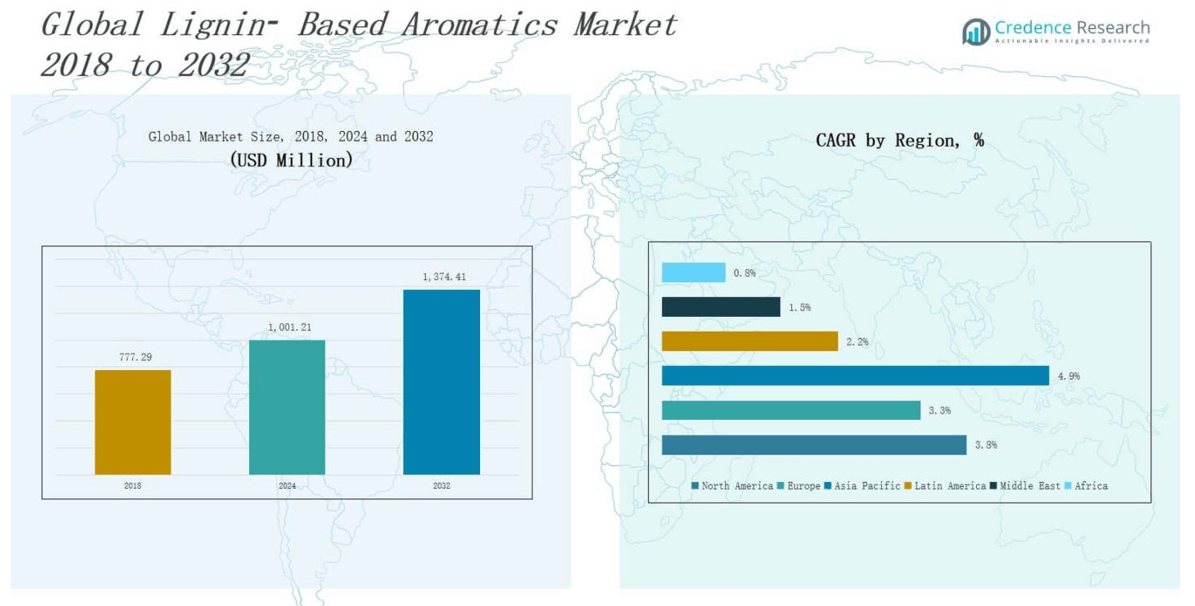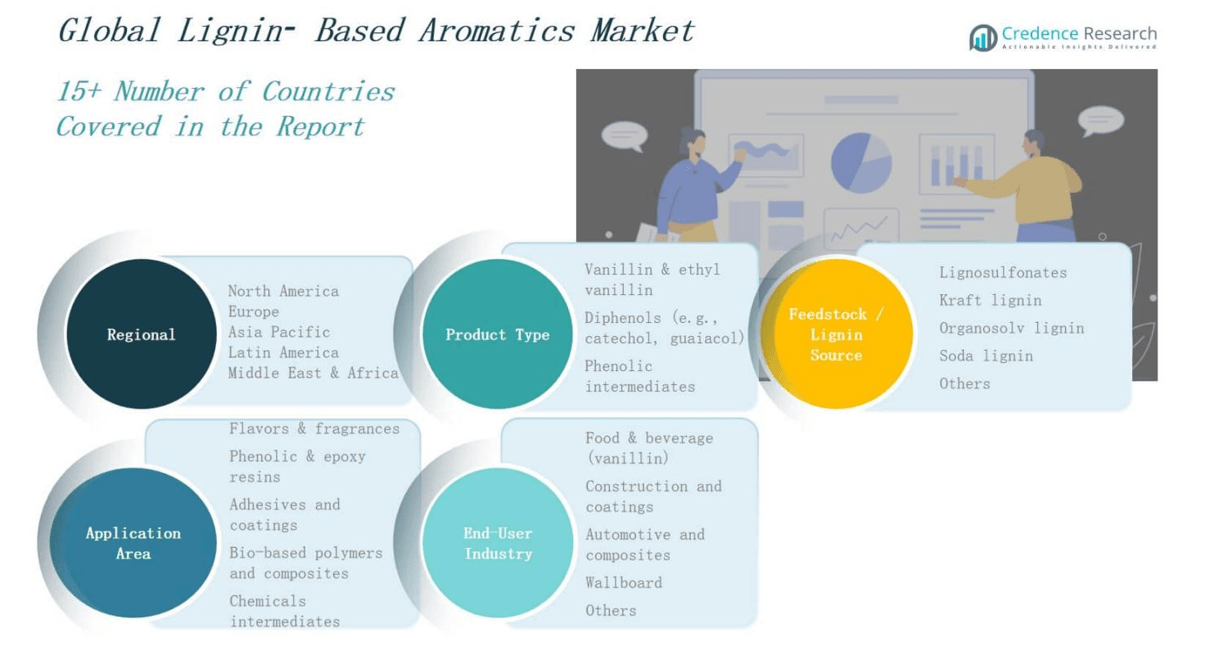CHAPTER NO. 1: GENESIS OF THE MARKET
1.1 Market Prelude – Introduction & Scope
1.2 The Big Picture – Objectives & Vision
1.3 Strategic Edge – Unique Value Proposition
1.4 Stakeholder Compass – Key Beneficiaries
CHAPTER NO. 2: EXECUTIVE LENS
2.1 Pulse of the Industry – Market Snapshot
2.2 Growth Arc – Revenue Projections (USD Million)
2.3. Premium Insights – Based on Primary Interviews
CHAPTER NO. 3: LIGNIN‑BASED AROMATICS MARKET FORCES & INDUSTRY PULSE
3.1 Foundations of Change – Market Overview
3.2 Catalysts of Expansion – Key Market Drivers
3.2.1 Momentum Boosters – Growth Triggers
3.2.2 Innovation Fuel – Disruptive Technologies
3.3 Headwinds & Crosswinds – Market Restraints
3.3.1 Regulatory Tides – Compliance Challenges
3.3.2 Economic Frictions – Inflationary Pressures
3.4 Untapped Horizons – Growth Potential & Opportunities
3.5 Strategic Navigation – Industry Frameworks
3.5.1 Market Equilibrium – Porter’s Five Forces
3.5.2 Ecosystem Dynamics – Value Chain Analysis
3.5.3 Macro Forces – PESTEL Breakdown
3.6 Price Trend Analysis
3.6.1 Regional Price Trend
3.6.2 Price Trend by Product Type
CHAPTER NO. 4: KEY INVESTMENT EPICENTER
4.1 Regional Goldmines – High-Growth Geographies
4.2 Product Frontiers – Lucrative Product Categories
4.3 Application Sweet Spots – Emerging Demand Segments
CHAPTER NO. 5: REVENUE TRAJECTORY & WEALTH MAPPING
5.1 Momentum Metrics – Forecast & Growth Curves
5.2 Regional Revenue Footprint – Market Share Insights
5.3 Segmental Wealth Flow – Product Type & Application Area Revenue
CHAPTER NO. 6: TRADE & COMMERCE ANALYSIS
6.1. Import Analysis by Region
6.1.1. Global Lignin‑Based Aromatics Market Import Revenue By Region
6.2. Export Analysis by Region
6.2.1. Global Lignin‑Based Aromatics Market Export Revenue By Region
CHAPTER NO. 7: COMPETITION ANALYSIS
7.1. Company Market Share Analysis
7.1.1. Global Lignin‑Based Aromatics Market: Company Market Share
7.2. Global Lignin‑Based Aromatics Market Company Revenue Market Share
7.3. Strategic Developments
7.3.1. Acquisitions & Mergers
7.3.2. New Product Type Launch
7.3.3. Regional Expansion
7.4. Competitive Dashboard
7.5. Company Assessment Metrics, 2024
CHAPTER NO. 8: LIGNIN‑BASED AROMATICS MARKET – BY PRODUCT TYPE SEGMENT ANALYSIS
8.1. Lignin‑Based Aromatics Market Overview by Product Type Segment
8.1.1. Lignin‑Based Aromatics Market Revenue Share By Product Type
8.2. Vanillin & ethyl vanillin
8.3. Diphenols (e.g., catechol, guaiacol)
8.3. Phenolic intermediates
CHAPTER NO. 9: LIGNIN‑BASED AROMATICS MARKET – BY FEEDSTOCK / LIGNIN SOURCE SEGMENT ANALYSIS
9.1. Lignin‑Based Aromatics Market Overview by Feedstock / Lignin Source Segment
9.1.1. Lignin‑Based Aromatics Market Revenue Share By Feedstock / Lignin Source
9.2. Lignosulfonates
9.3. Kraft lignin
9.4. Organosolv lignin
9.5. Soda lignin
9.6. Others
CHAPTER NO. 10: LIGNIN‑BASED AROMATICS MARKET – BY APPLICATION AREA SEGMENT ANALYSIS
10.1. Lignin‑Based Aromatics Market Overview by Application Area Segment
10.1.1. Lignin‑Based Aromatics Market Revenue Share By Application Area
10.2. Flavors & fragrances
10.3. Phenolic & epoxy resins
10.4. Adhesives and coatings
10.5. Bio-based polymers and composites
10.6. Chemicals intermediates
CHAPTER NO. 11: LIGNIN‑BASED AROMATICS MARKET – BY END-USER INDUSTRY SEGMENT ANALYSIS
11.1. Lignin‑Based Aromatics Market Overview by End-User Industry Segment
11.1.1. Lignin‑Based Aromatics Market Revenue Share By End-User Industry
11.2. Food & beverage (vanillin)
11.3. Construction and coatings
11.4. Automotive and composites
11.5. Wallboard
11.6. Others
CHAPTER NO. 12: LIGNIN‑BASED AROMATICS MARKET – REGIONAL ANALYSIS
12.1. Lignin‑Based Aromatics Market Overview by Region Segment
12.1.1. Global Lignin‑Based Aromatics Market Revenue Share By Region
12.1.2. Regions
12.1.3. Global Lignin‑Based Aromatics Market Revenue By Region
12.1.4. Product Type
12.1.5. Global Lignin‑Based Aromatics Market Revenue By Product Type
12.1.6. Feedstock / Lignin Source
12.1.7. Global Lignin‑Based Aromatics Market Revenue By Feedstock / Lignin Source
12.1.8. Application Area
12.1.9. Global Lignin‑Based Aromatics Market Revenue By Application Area
12.1.10. End-User Industry
12.1.11. Global Lignin‑Based Aromatics Market Revenue By End-User Industry
CHAPTER NO. 13: NORTH AMERICA LIGNIN‑BASED AROMATICS MARKET – COUNTRY ANALYSIS
13.1. North America Lignin‑Based Aromatics Market Overview by Country Segment
13.1.1. North America Lignin‑Based Aromatics Market Revenue Share By Region
13.2. North America
13.2.1. North America Lignin‑Based Aromatics Market Revenue By Country
13.2.2. Product Type
13.2.3. North America Lignin‑Based Aromatics Market Revenue By Product Type
13.2.4. Feedstock / Lignin Source
13.2.5. North America Lignin‑Based Aromatics Market Revenue By Feedstock / Lignin Source
13.2.6. Application Area
13.2.7. North America Lignin‑Based Aromatics Market Revenue By Application Area
13.2.8. End-User Industry
13.2.9. North America Lignin‑Based Aromatics Market Revenue By End-User Industry
13.3. U.S.
13.4. Canada
13.5. Mexico
CHAPTER NO. 14: EUROPE LIGNIN‑BASED AROMATICS MARKET – COUNTRY ANALYSIS
14.1. Europe Lignin‑Based Aromatics Market Overview by Country Segment
14.1.1. Europe Lignin‑Based Aromatics Market Revenue Share By Region
14.2. Europe
14.2.1. Europe Lignin‑Based Aromatics Market Revenue By Country
14.2.2. Product Type
14.2.3. Europe Lignin‑Based Aromatics Market Revenue By Product Type
14.2.4. Feedstock / Lignin Source
14.2.5. Europe Lignin‑Based Aromatics Market Revenue By Feedstock / Lignin Source
14.2.6. Application Area
14.2.7. Europe Lignin‑Based Aromatics Market Revenue By Application Area
14.2.8. End-User Industry
14.2.9. Europe Lignin‑Based Aromatics Market Revenue By End-User Industry
14.3. UK
14.4. France
14.5. Germany
14.6. Italy
14.7. Spain
14.8. Russia
14.9. Rest of Europe
CHAPTER NO. 15: ASIA PACIFIC LIGNIN‑BASED AROMATICS MARKET – COUNTRY ANALYSIS
15.1. Asia Pacific Lignin‑Based Aromatics Market Overview by Country Segment
15.1.1. Asia Pacific Lignin‑Based Aromatics Market Revenue Share By Region
15.2. Asia Pacific
15.2.1. Asia Pacific Lignin‑Based Aromatics Market Revenue By Country
15.2.2. Product Type
15.2.3. Asia Pacific Lignin‑Based Aromatics Market Revenue By Product Type
15.2.4. Feedstock / Lignin Source
15.2.5. Asia Pacific Lignin‑Based Aromatics Market Revenue By Feedstock / Lignin Source
15.2.6. Application Area
15.2.7. Asia Pacific Lignin‑Based Aromatics Market Revenue By Application Area
15.2.8. End-User Industry
15.2.9. Asia Pacific Lignin‑Based Aromatics Market Revenue By End-User Industry
15.3. China
15.4. Japan
15.5. South Korea
15.6. India
15.7. Australia
15.8. Southeast Asia
15.9. Rest of Asia Pacific
CHAPTER NO. 16: LATIN AMERICA LIGNIN‑BASED AROMATICS MARKET – COUNTRY ANALYSIS
16.1. Latin America Lignin‑Based Aromatics Market Overview by Country Segment
16.1.1. Latin America Lignin‑Based Aromatics Market Revenue Share By Region
16.2. Latin America
16.2.1. Latin America Lignin‑Based Aromatics Market Revenue By Country
16.2.2. Product Type
16.2.3. Latin America Lignin‑Based Aromatics Market Revenue By Product Type
16.2.4. Feedstock / Lignin Source
16.2.5. Latin America Lignin‑Based Aromatics Market Revenue By Feedstock / Lignin Source
16.2.6. Application Area
16.2.7. Latin America Lignin‑Based Aromatics Market Revenue By Application Area
16.2.8. End-User Industry
16.2.9. Latin America Lignin‑Based Aromatics Market Revenue By End-User Industry
16.3. Brazil
16.4. Argentina
16.5. Rest of Latin America
CHAPTER NO. 17: MIDDLE EAST LIGNIN‑BASED AROMATICS MARKET – COUNTRY ANALYSIS
17.1. Middle East Lignin‑Based Aromatics Market Overview by Country Segment
17.1.1. Middle East Lignin‑Based Aromatics Market Revenue Share By Region
17.2. Middle East
17.2.1. Middle East Lignin‑Based Aromatics Market Revenue By Country
17.2.2. Product Type
17.2.3. Middle East Lignin‑Based Aromatics Market Revenue By Product Type
17.2.4. Feedstock / Lignin Source
17.2.5. Middle East Lignin‑Based Aromatics Market Revenue By Feedstock / Lignin Source
17.2.6. Application Area
17.2.7. Middle East Lignin‑Based Aromatics Market Revenue By Application Area
17.2.8. End-User Industry
17.2.9. Middle East Lignin‑Based Aromatics Market Revenue By End-User Industry
17.3. GCC Countries
17.4. Israel
17.5. Turkey
17.6. Rest of Middle East
CHAPTER NO. 18: AFRICA LIGNIN‑BASED AROMATICS MARKET – COUNTRY ANALYSIS
18.1. Africa Lignin‑Based Aromatics Market Overview by Country Segment
18.1.1. Africa Lignin‑Based Aromatics Market Revenue Share By Region
18.2. Africa
18.2.1. Africa Lignin‑Based Aromatics Market Revenue By Country
18.2.2. Product Type
18.2.3. Africa Lignin‑Based Aromatics Market Revenue By Product Type
18.2.4. Feedstock / Lignin Source
18.2.5. Africa Lignin‑Based Aromatics Market Revenue By Feedstock / Lignin Source
18.2.6. Application Area
18.2.7. Africa Lignin‑Based Aromatics Market Revenue By Application Area
18.2.8. End-User Industry
18.2.9. Africa Lignin‑Based Aromatics Market Revenue By End-User Industry
18.3. South Africa
18.4. Egypt
18.5. Rest of Africa
CHAPTER NO. 19: COMPANY PROFILES
19.1. Borregaard ASA (Borregaard LignoTech)
19.1.1. Company Overview
19.1.2. Product Type Portfolio
19.1.3. Financial Overview
19.1.4. Recent Developments
19.1.5. Growth Strategy
19.1.6. SWOT Analysis
19.2. Domtar Corporation
19.3. Domsjö Fabriker (Aditya Birla Group)
19.4. Nippon Paper Industries Co., Ltd.
19.5. Stora Enso Oyj
19.6. UPM‑Kymmene Corporation
19.7. Lignin Industries AB
19.8. MetGen
19.9. Ingevity Corporation
19.10. Lignolix
19.11. GreenValue Enterprises LLC / Green Agrochem-Lignin
19.12. Sappi Ltd.
19.13. Metsa Group / Metsa Fibre
19.14. Suzano S.A.
19.15. Camlin Fine Sciences Ltd.









